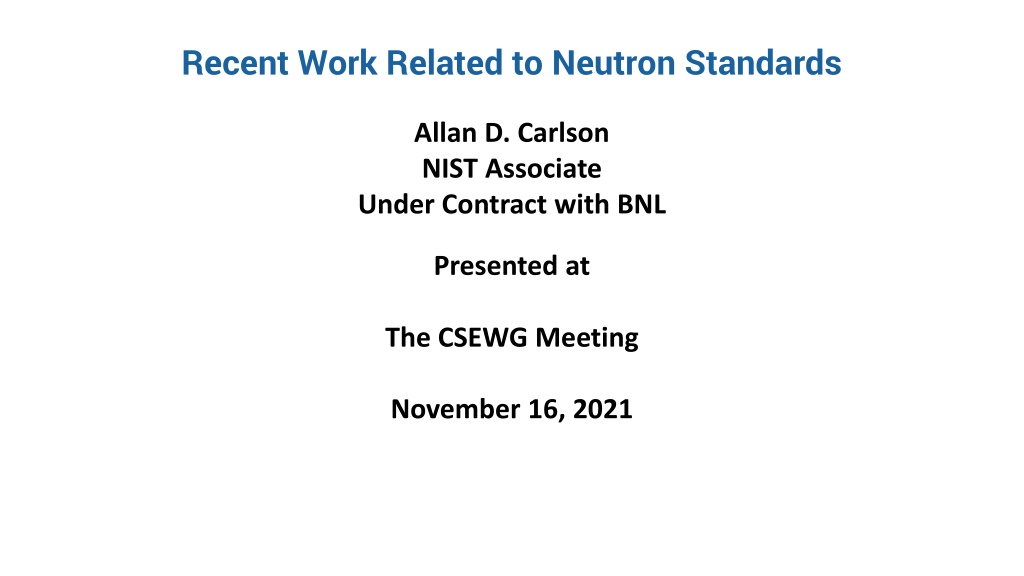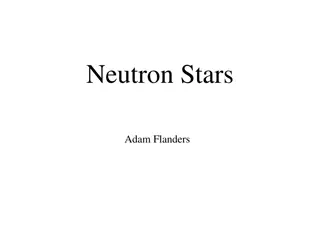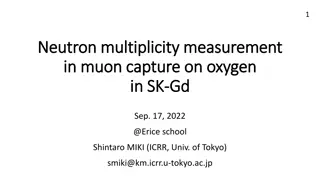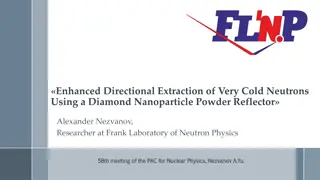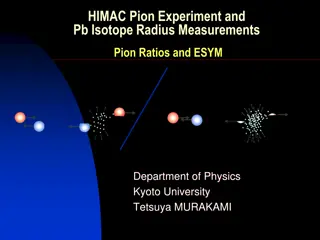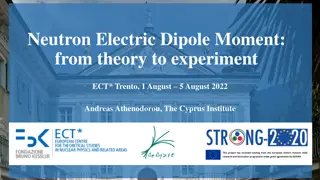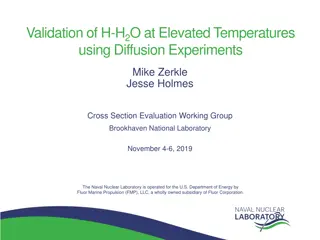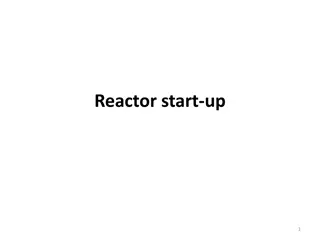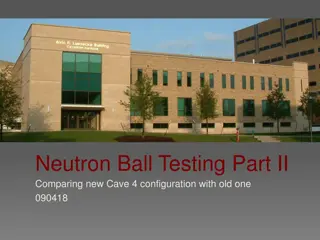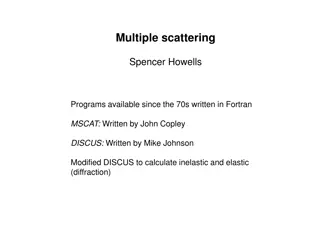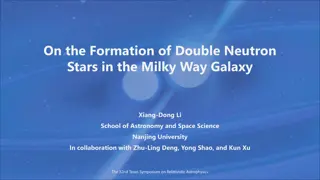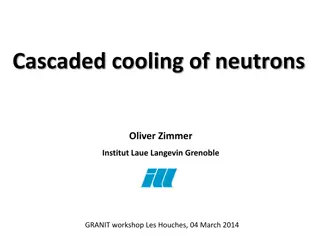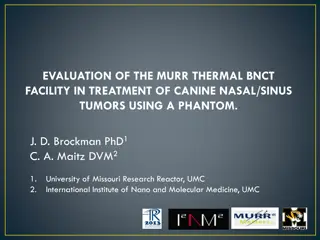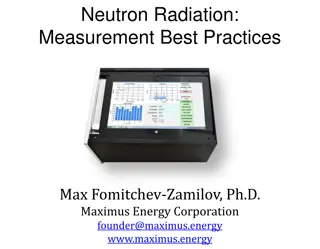Recent Advancements in Neutron Standards Evaluation
Recent work by Allan D. Carlson, a NIST associate under contract with BNL, was presented at the CSEWG meeting discussing possible changes to neutron standards and showcasing important measurements, such as H(n,n)H angular distribution data by Jiang et al. and 6Li(n,t) reaction measurements by Bai et al. These measurements provide valuable insights for the evaluation and improvement of neutron standards. The presentation highlighted advancements in data quality, energy range extension, and angular distribution accuracy, paving the way for enhanced neutron standards evaluation in the future.
Download Presentation

Please find below an Image/Link to download the presentation.
The content on the website is provided AS IS for your information and personal use only. It may not be sold, licensed, or shared on other websites without obtaining consent from the author. Download presentation by click this link. If you encounter any issues during the download, it is possible that the publisher has removed the file from their server.
E N D
Presentation Transcript
Recent Work Related to Neutron Standards Allan D. Carlson NIST Associate Under Contract with BNL Presented at The CSEWG Meeting November 16, 2021
The Focus is on Possible Changes to the Neutron Standards Since the Last Standards Evaluation Not all standards will be discussed only relatively new data where important changes may occur Measurements will be discussed that will have an impact on the new evaluation of the Neutron Standards Possible changes in standards will be suggested but since the evaluation has not been done, final results can not be given
H(n,n)H Angular Distribution A very important measurement was done by Jiang et al. Differential cross section data were obtained at 10 angles from 10 to 55 degrees. The measurements extend from 6 MeV to 52 MeV with 23 energy points. The flight path was 57.99m. The measurements generally agree well compared with existing measurements, evaluations and theoretical calculations, The hydrogen standard is limited to 20 MeV at the present time. The Jiang et al. data combined with the database being developed by Paris and Hale at LANL will allow an evaluation with an extended energy range to be produced. The present results are up to 50 MeV and Paris is hoping to have data up to 100 MeV by this CSEWG meeting.
H(n,n)H Angular Distribution Measurements by Jiang et al. 27 (w) (u) En = 52.48 4.64 MeV En = 37.83 2.83 MeV 24 16 21 ds s/ /dW W (mb/sr) ds s/ /dW W (mb/sr) 18 12 15 JENDL-4.0/He-2015 = FENDL-3.1d J. P. Scanlon (1963, 37.5 5.0 MeV) E. Tagliaferri (1966, 40.0 4.0 MeV) J. L. Romero (1970, 36.0 MeV) A. Bol (1985, 40.0 1.6 MeV, normolized using s s(n, el),c. m. G. Fink (1990, 40.0 2.0 MeV) S. Benck (1997, 37.5 1.5 MeV) Present (normolized using s s(n, el),c. m. 12 JENDL-4.0/He-2015 = FENDL-3.1d G. Fink (1963, 52.5 5.0 MeV) T. C. Montgomery (1977, 50.0 MeV) A. Bol (1985, 50.0 1.4 MeV, normolized using s s(n, el),c. m. G. Fink (1990, 50.0 2.0 MeV) S. Benck (1997, 53.0 2.2 MeV, Present (normolized using s s(n, el),c. m. 8 9 40.0 MeV, 90.0 = 15.57 mb/sr) 6 50.0 MeV, 90.0 = 11.11 mb/sr) 4 3 52.48 MeV, 149.8 = 14.64 mb/sr) 37.83 MeV, 149.8 = 21.00 mb/sr) 0 0 0 20 40 60 80 100 120 140 160 180 0 20 40 60 80 100 120 140 160 180 q qc. m. (deg) q qc. m. (deg)
6Li(n,t) Measurements Measurements have been made by Bai et al. that extend from 1 eV to 3 MeV with 80 energy groups and angular distribution measurements at each energy group for 15 angles between 19.2 and 160.8 degrees. Those data were normalized to the present standard in the interval from 0.1 to 0.4 MeV. The data may be overall the most complete, and best-quality, set of relative differential cross sections for the 6Li(n,t)reaction that presently exists at energies below 3 MeV. The neutron energy spectrum was not measured at the position of the experiment. It is expected that this will affect the cross section values. It will not affect the angular distributions. There are deviations from an isotropic angular distribution in the eV energy region. Some of this may be from problems due to the use of the 235U(n,f) cross section for determining the neutron fluence in regions where it is not smooth. Also the integrated cross sections are below the standard for energies above 0.5 MeV, but within uncertainties. The magnitude of the cross section at the resonace peak differs from expected values. The agreement with the standard in many regions is relatively good. More work is planned. It is important to extend the energy range of this standard to above 1 MeV, the present limit of this standard. That would allow convenient overlap with H(n,n) standard. The Bai et al. data could possibly allow an energy range increase for this standard with more work on this experiment.
6Li(n,t) Angular Distributions Measurements by Bai et al. (cont.)
10B(n, ) and 10B(n, 1 ) Measurements Several measurements of the10Be(p,n)10B reaction have been made by Massey and Jones-Aberty at Ohio University. The data include a measured excitation function at zero degrees and two selected angular distributions. Also a total neutron yield for the reaction was measured. Massey et al. have measured 10B(n,Z) reactions for neutron energies from 2 to 20 MeV. The work was done at the LANSCE WNR facility where proton, triton and alpha particles were measured at four angles. Differential cross sections were obtained for the 10B(n,p0)10Be, 10B(n,t0)8Be, 10B(n,a2)7Li and 10B(n,a3)7Li reactions. The sum of the 10B(n,a0)7Li and 10B(n,a1)7Li differential cross section was measured. Partial angular distributions were obtained for the 10B(n,p1)10Be, 10B(n,t1)8Be and 10B(n,d0)9Be reactions. It has been submitted for publication. This wide range of data can all be used in R-matrix fits to improve the 10B standards since they all have the 11B compound nucleus. This cross section is now a standard only up to 1 MeV. These data should help in extending the energy of this standard to higher energies, possibly 3 MeV or higher.
10B(n, ) and 10B(n, ) Measurements (continued) Work by Jiang et al. extends from 1 eV to 2.5 MeV with 59 energy groups. Data were obtained with at 15 angles between 19.2 and 160.8 degrees. These data were normalized to the present standard in the interval from 0.3 to 0.5 MeV. This is a very comprehensive complete set of measurements up to 2.5 MeV. The neutron energy spectrum was not measured at the position of the experiment. It will not affect the angular distributions. It was not possible to separate the a0 and a1 peaks for energies above 1 MeV. There are a number of cases where both the 10B(n, 1) and 10B(n, ) differential cross section data are somewhat low compared with the standard. The integrated 10B(n, )cross section data are largely in good agreement but somewhat low in the several hundred keV energy region compared with the standard. The neutron fluence was the same for the Jiang boron measurements and the Bai lithium measurements. One experiment followed the other. Many problems in these experiments were remove by making them ratio data. A new experiment is planned where more precise appropriate spectrum measurement will be made. Also to improve separation of alpha peaks, a thinner sample and higher resolution detectors will be used then. These data in addition to those of Massey et al. should help in extending the energy of this standard to higher energies.
C(n,n) Cross Section The most recent evaluation of the carbon standard by Hale was done by combining 12C and 13C R-matrix evaluations to obtain the elemental cross section that is the standard. That evaluation, the ENDF/B-VIII standards evaluation (the 2017 standard), is somewhat higher than the ENDF/B-VII standards evaluation (the 2006 standard). The difference is most noticeable at the highest energies. Danon at RPI made total cross section measurements that are slightly lower than the 2017 standard values in the 150 to 400 keV energy region. Those data with uncertainties from a fraction of a percent to about 1% are in better than 1% agreement with the 2006 standards evaluation. Data at RPI also indicate differences with both evaluations at back angles (about 156 degrees) in the standards energy region. Hale is investigating this now
Fission Cross Section Measurements Absolute measurements by the n_TOF collaboration were made of the 235U(n,f) cross section relative to hydrogen scattering from 10 MeV to 1 GeV. The analysis of the data from 10 MeV to 150 MeV is being done by Pirovano et al. The data analysis up to 1 GeV by Manna et al. is underway. The present standard is limited to 200 MeV. There is a strong need for an extension to higher neutron energies that may be possible with these data. Absolute measurements of the 238U(n,f)/ 235U(n,f) cross section ratio were made by Wen et al. up to 20 MeV. They agree with the standards results within their uncertainties of 2.3% to 3.6% . The Casperson et al., NIFFTE collaboration, measurements at LANSCE of the 238U(n,f)/235U(n,f) cross section ratio have been shown here previously. The data that extend to 30 MeV were normalized at 14.5 MeV to the present standards values. The agreement is quite good with the standard except in the region between about 2 and several MeV where their results are a percent or so low compared with the standard but generally within the uncertainties of the standard. 239Pu(n,f)/235U(n,f) cross section ratio measurements by Snyder et al. made at LANSCE by the NIFFTE collaboration have been submitted for publication. Those data are higher than the standards evaluation by about 2%. They agree in shape with the standards evaluation. New measurements are underway with an improved sample,
238U(n,f)/ 235U(n,f) Cross Section Ratio Measurement at CSNS for One Cell Combination by Wen et al.
Comparison of the NIFFTE 239Pu(n,f)/ 235U(n,f) Cross Section Ratio with the Standards Evaluation
Use of Integral Data Starting with the standards for the ENDF/B-VI evaluation, very clean integral data were used. The data used were measurements of the 235U(n,f) and 239Pu(n,f) cross sections in the 252Cf spontaneous fission neutron spectrum (SACSs). Since there is a relatively small change in the cross section for these nuclides over most of the energy range of the 252Cf spectrum, an accurate determination of the cross section is possible. The result is also only weakly dependent on the uncertainty in the spectrum shape. These integral data basically help provide normalization for the standards evaluation. It was discovered that the spectrum averaged cross section values in our standards evaluation differed slightly from those in an IRDFF evaluation for the dosimetry community by Mannhart. This has led to an investigation of the two databases and concerns about some experiments due to insufficient documentation. Several other studies of inconsistencies are underway. This investigation is ongoing with no definite conclusions. Unfortunately, some data such as SACS ratios can not be handled directly in GMA.
Additional Work that Impacts the Determination of the Standards Additional effort by Neudecker et al. on inspection of uncertainty sources for standards measurements All data in the GMA database should be used and correlations should be taken into account for this investigation Further work on unrecognized sources of uncertainty Inspection of data sets for unrecognized sources of uncertainty and correlations in data Investigation of the energy dependence of USU for each standard Improved evaluation techniques for the standard cross sections The items above will be discussed at a virtual standards meeting on Dec. 6-10 in addition to: Reviewing new experimental data Discussing changes in the evaluation methodology and uncertainty quantification Quantifying differences between new evaluations and the IAEA standards issued in 2017
